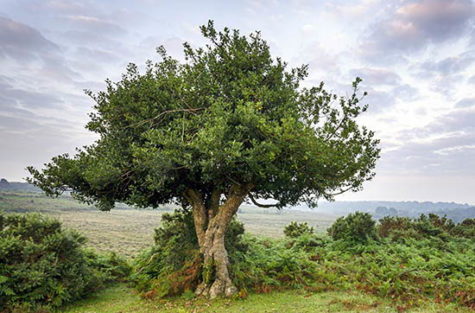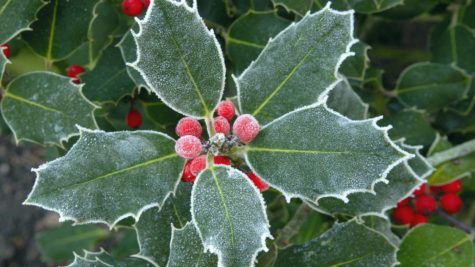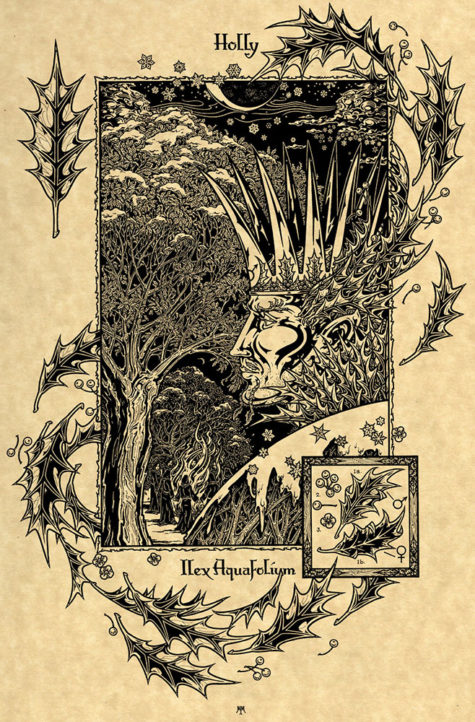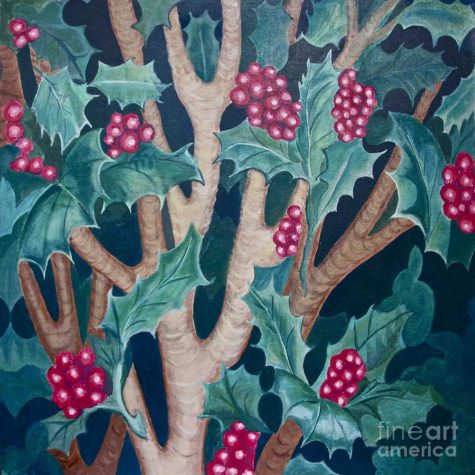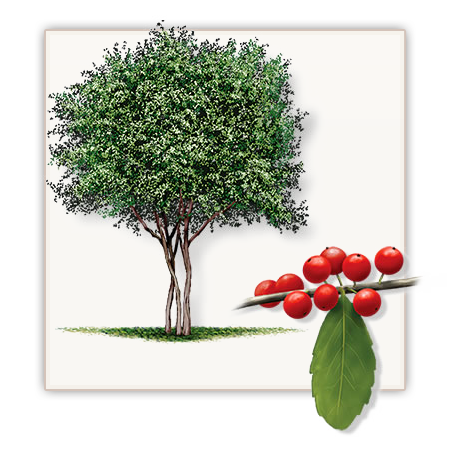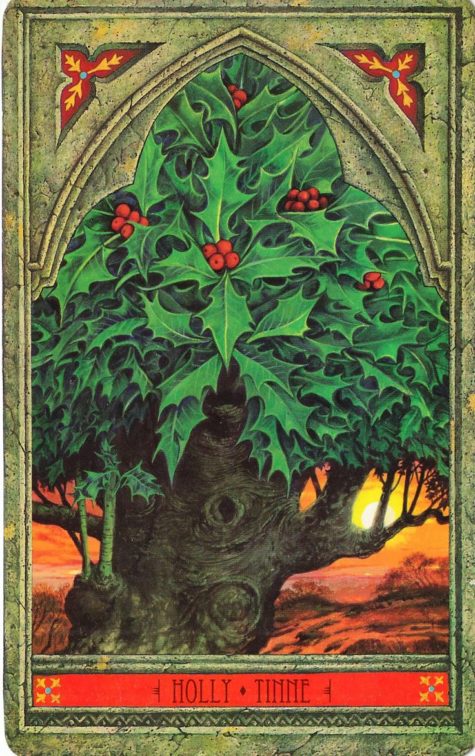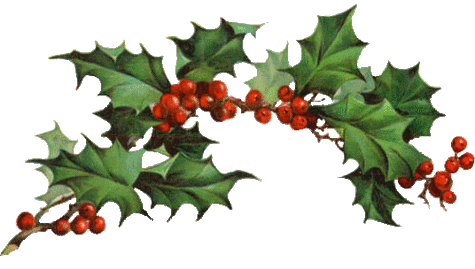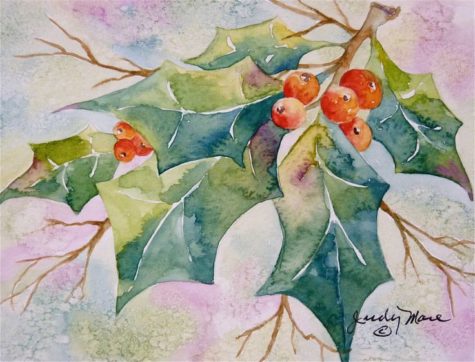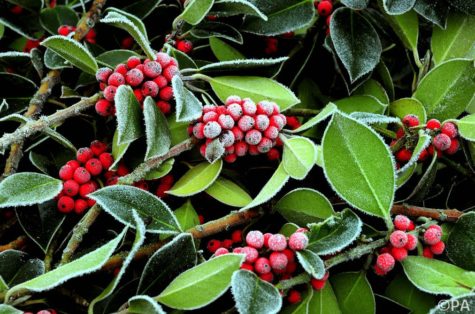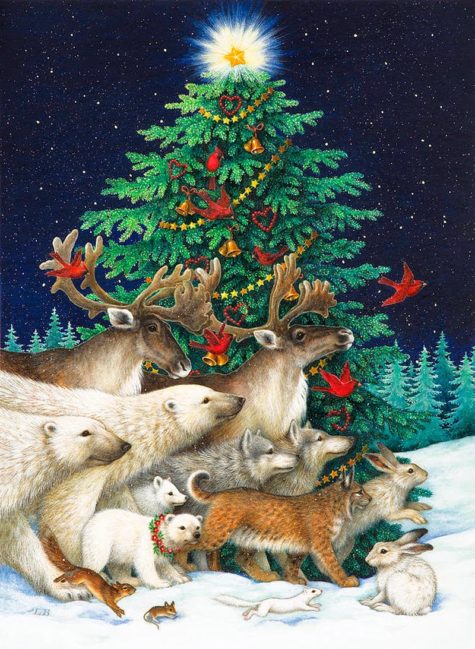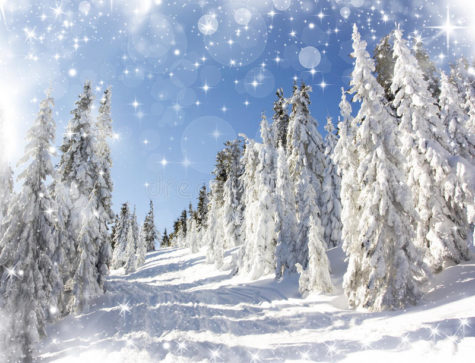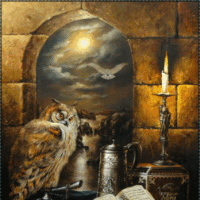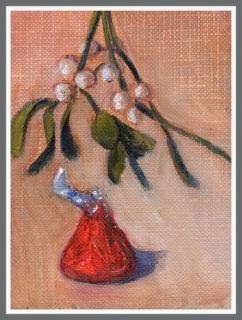Christmas
- Latin Name: Ilex aquifolium, Ilex opaca (American Holly)
- Celtic name: Tinne (pronounced: chihn’ uh)
- Known as: Tree of Sacrifice
- Folk or Common names: Holly, Aquifolius, Bat’s Wings, Christ’s Thorn, Holm Chaste, Hulm, Hulver Bush, Scarlet Oak, Kerm-Oak, Holy Tree
- Meanings: Holly actually means “holy”.
- Ruling Planets: Mars and Saturn
- Element: Fire
- Ruler: Sun
- Stone: Ruby, Bloodstone
- Birds: Cardinal, Starling
- Color: Red
- Deity: Lugh, Tannus, Thor, Danu
- Other: The Holly is an evergreen tree.
- Magickal Form: Wreaths, berries, leaves, wood
- NOTE: Holly berries are poisonous!
- Powers: Protection, Anti-Lightning, Luck, Dream Magick
Holly, being evergreen and having red berries, is a symbol of enduring life, and consequently it is considered a lucky plant almost everywhere. It is very unlucky to cut down a Holly tree.
The Holly Tree is one of the Seven Chieftain Trees of the Druids, its very name means “holy.” A Christian myth says that the blood of Christ formed the red berries of the holly. Holly is also associated with unicorns, since the unicorn is one of the Celtic symbols for this tree – the other symbol is the Flaming Spear.
Holly berries represent the blood of the Goddess. Use Holly berries with your favorite spell for female fertility and sexuality. Holly tames wild beasts and wards off storms and bad weather. Since it is a masculine herb, it brings good luck to men. The Romans considered Holly sacred and used it as a decoration during their Saturnalia celebrations.
Holly is sacred to the Winter Solstice, when it is used for decorating. Decorating one’s home with holly was believed to bring protection and good luck to the inhabitants in the coming year. Holly was used for decoration throughout homes with it being used for boughs over entrances to peoples’ homes or formed into holly wreaths that were hung on doors.
Sprigs of holly in the house at Christmastime will bring you good luck. But… be careful not to bring it indoors before Christmas Eve or your family will fall to squabbling. (Bet you wondered why that happened. grin…) Also be sure to burn it on 12th night (January 5th) or the good luck will turn sour.
Holly was the gift of good luck among the Romans celebrating their midwinter festivals. The northern tribes, who eventually brought about Rome’s downfall draped holly over doorways as shelter for friendly woodland spirits who could bring good luck to their houses.
The custom of bringing holly boughs into the home in the depths of winter has its origins in the original pre-Christian idea that its prickly leaves sheltered the fairy folk, who were delighted to come indoors at such a cold time of the year.
The wreaths are very popular around the Christmas / Yuletide season. Placing a ring of holly on doors originated in Ireland since holly was one of the main plants that was green and very beautiful with its red berries at this time of year and gave poor people a means of decorating their dwellings.
Unlike mistletoe, it appears in the Christmas Greenery of churches as well as ordinary houses. In some districts, when the rest of the decorations are burnt or thrown away at the end of the holiday, a holly-sprig is kept, to protect the house from lightning during the coming year.
- Planted near a house, holly repels negative spells sent against you.
- A bag of leaves and berries carried by a man increases his ability to attract women.
- Burn Holly leaves with Blessing Incense to protect the home and draw good luck.
- Place Holly above the door lintel for protection and to invite helpful spirits.
- Carry Holly berries in your pocket for protection.
The Holly tree (of which there are well over 150 species) can grow (albeit very slowly) to be as high as fifty feet and is native to most of Central and Southern Europe. Its white, star-shaped flowers bloom in the Spring and it bears shiny red berries in Autumn which last throughout the Winter season. The leaves of the Holly are shiny, dark green in color, elliptical in shape and have spiny points. In order to produce berries, both a male and a female tree are required. Only the female tree produces berries which, although lovely to look at, are poisonous.
Given its evergreen nature, the Holly represented immortality and was one of the Nine Sacred Woods used in Need-Fires (the others being Oak, Pine, Hazel, Juniper, Cedar, Poplar, Apple and Ash). In ancient Irish lore, it was also listed as one of the Noble Trees of the Grove (along with Birch, Alder, Willow, Oak, Hazel and Apple).
The Holly tree has a fine white wood which was once used in the making of inlays and for walking sticks as well as riding crops. Its leaves are a favorite food among deer and sheep during the Winter months. The wood of the Holly is hard, compact and beautifully white in color, being susceptible of a very high polish.
Magical History and Associations:
Each month of the Celtic Lunar calendar bears the name of a tree. Holly is the 8th Moon of the Celtic Year – (July 8 – Aug 4).
The Holly, a masculine herb, is associated with the element of fire, and is an herb of Saturn and Mars. The bird associated with this month is the starling, the color is green-gray, the gemstone is yellow caingorm, and the day of the week association is Tuesday. Holly is the first moon of the dark half of the year, and the Holly is sacred to both the Winter and Summer Solstices.
Summer Solstice is the time when in mythology, the Oak King is slain by his twin, or tanist, the Holly King, who rules until the Winter Solstice, when he in turn is slain by his tanist, the Oak King. Tanist is related to the tannin found in an Oak tree; Oak and Holly are two sides of the same coin, the end of one cycle and the beginning of the next.
Holly is one of the three timbers in the Chariot Wheel. It represents personal sacrifice in order to gain something of greater value.
The Holly is also sacred to the deities of Lugh, Habondia, Tina Etruscan and Tannus. There are special spirits that dwell within Holly trees: the Holly Man lives in the tree that bears prickly Holly, and the Holly Woman dwells within that which give forth smooth and variegated leaves.
Magickal usage:
The month of Holly is a good time to do magick designed to help bring about a successful harvest. The Holly has applications in magick done for protection, prophesy, healing, magick for animals, sex magick, invulnerability, watchfulness, good luck, death, rebirth, Holiness, consecration, material gain, physical revenge, beauty and travel.
Dreaming of Holly means you should be mindful of what is troubling you, and picking holly in your dreams means you will have a long life.
Holly also has the ability to enhance other forms of magic. As a symbol of firmness and masculine energy, Holly wood was used by the ancients in the construction of spear shafts, which were thought to then have magickal powers. Uses of Holly in protective magick includes hanging a sprig of Holly in the home all year to insure protection and good luck. Holly is also an excellent charm to wear for protection.
‘Holly Water’ can be made by soaking Holly overnight in spring water under a full moon. This water can then be sprinkled over infants to keep them happy and safe. Holly Water can also be used to sprinkle around the house for psychic cleansing and protection.
A “par excellence” protective herb, it protects against lightning, poison, and evil spirits. When thrown at wild animals it makes them lie down quietly and leave you alone. Holly leaves can be cast around outside to repel unwanted spirits or animals and a Holly bush can be planted close to houses to protect against lightning. Ensure that the Holly has a place in your garden because its presence wards off unfriendly spirits. Do not burn Holly branches unless they are well and truly dead, for this is unlucky.
Holly is considered the male counterpart to the female Ivy. Holly, intertwined with ivy, is traditionally made into crowns for the bride and groom at weddings/handfastings. Holly and Ivy also make excellent decorations for altars.
Holly is also a traditional decoration for Yuletide as in sung in the traditional Yuletide song:
“Deck the halls with boughs of Holly,
fa la la la la, la la la la.”
Even though Holly’s Yule festival greens are traditionally burned at Imbolg, a small sprig us kept for luck and to keep evil away throughout the year. Holly berries were used to predict winter weather. If there were a profusion of berries, that meant it would be a hard winter, because the Goddess was providing extra berries for the birds.
When harvesting the leaves from the Holly, remember to ask the tree if it will allow you to take the parts and be sure to leave the tree an offering of thanks when you are done. Holly favors red and yellow stones as gifts.
A north country charm to induce dreams of a future mate required the seeker to go out in silence at midnight on a Friday, and gather nine she-holly leaves (the smooth variegated variety). These had to be tied with nine knots in a three-cornered handkerchief, and laid under the pillow before going to bed. The future husband or wife would appear in a dream, but only if complete silence had been preserved from the moment of setting out to gather the leaves until dawn the next day.
The Deeper Meaning of Holly
It is during June that the light of the sun reaches its culmination, and then begins its descent into earth. The Holly speaks to the fierce capacity of the human soul to take the descent into the underworld, bringing inner light into darkness. Thus we can understand the signature of the tree, with its ability to germinate without sunlight, favoring dark, moist conditions that are more strongly related to the downward earth pole. Its stiff, pointed leaves are not unlike thorns or “spears.”
The Holly yields a hard, white close-grained wood that imparts a quality of solidity and impermeability, as it stands in the depths of winter, impervious to cold and darkness with its somber evergreen color.
The Druid initiates developed a sacred alphabet, called the Ogham, based upon the archetypal qualities of trees. The Holly, known in Gaelic as Tinne ruled the eighth moon of the year, or the month of June. The glyph for Holly is that of a spear, meaning literally, “I am a battle-waging spear.”
Of all the trees in the Ogham, the Holly and the Oak are most primordial—they are viewed as two “kings” who exchange leadership on a yearly basis by engaging in symbolic battle. The Gaelic name for Holly—Tinne—is related to the word, tanist, meaning “dark twin.” The Oak King rules from the time the light begins its ascent in December until the summer solstice in June. Holly is the “dark twin” who reigns during the waning light of the year, until winter solstice.
The Holly’s prominence at Christmas is actually meant to represent a culminating experience within the soul life. It is an awakening of the love forces of the heart achieved through a descent into the interior of the self and the earth that comes to fruition during this festival. This understanding is depicted in Rudolf Steiner’s Calendar of the Soul.
Steiner is a modern initiate who incorporated the mystery streams of earlier cultures, including Druidic wisdom. His calendar is a series of 52 runic verses for each week of the year. Beginning at summer solstice, the soul gradually finds its way into an interior reality, moving out of the great cosmic heights. The sense of self coalesces like a seed, with light working into the inmost being, as a purifying and strengthening force. Then, at winter solstice, this light is quickened and shines forth from the heart chakra:
To carry spirit light into
World Winter-night
My heart is ardently impelled
That shining seeds of soul
Take root in world ground
And the Holy Word resounds
Through the darkness of the senses
Transfiguring all life.
In subsequent winter verses Steiner describes this activity of the soul as a “heart-high gladness”. It is the inner light of Self-containment gained by living in “spirit depths”—at one with the “world ground.” The soul is so solidly secure and anchored within itself that nothing can assail one’s sense of deep peace. When this consciousness is mastered, the journey inward of the Self is complete. The heart awakens with a streaming of love, gradually seeking its way outward into the sense world again to meet the expansive forces of the light in spring and summer.
We could say that the Holly flower which blooms in outer nature in late spring/summer, blossoms again in the human heart during winter as a force of love. Its nature is a sun force that lives, not in the heights but in the depths of the earth.
Perhaps the most profound archetypal picture of Holly is evoked through its symbolism as the Crown of Thorns. As the traditional Christmas carol proclaims, Of all the trees that are in the wood, the holly bears the crown.
Druid priests wore Holly in their hair while collecting the sacred mistletoe medicine in the winter, Holly was also worn as a crown to represent the Holly King in seasonal festivals. The Holly Crown was a sign of deepest respect and recognition that such an initiate had mastered the forces of nature in harmony with the human soul.
The Holly tree came to be known as Christ-Thorn in middle Europe, for it was recognized that this plant spoke to the archetypal reality of the Crown of Thorns as a soul initiation. The Crown of Thorns is also a kind of “beheading.” The false self must be pressed down with a Crown of Thorns until it finds a deeper truth in the human heart. The “battle waging spear” is thrust not outside, but within.
Holly teaches us that we cannot find love outside ourselves, if it is not anchored from within the human heart. Holly creates what is divine from within what is human. Holly helps the human heart know its own wholeness; its own holiness.
Herbal usage:
The powdered leaves were brewed into a healing tea for measles, fevers, bladder problems and bronchitis, and the ashes from burning the leaves in a drink soothed whooping cough.
Hot compresses made from the leaves and bark helped ease the pain of broken bones and dislocations. The juice of the fresh leaf is helpful in jaundice treatment. Holly can be used homeopathically as a substitute for quinine.
Note: Holly berries are poisonous!
Holly Folklore and Superstition
Male, or prickly, holly is lucky to men, as the smooth variegated type, known as the she-holly, is to women. If the First Foot on his rounds brings evergreens with him, it is usually holly that he chooses, but in this case it must be the male kind, for the other variety, being female, would be very ill-omened.
Holly branches must never be burned when green. To do this is extremely unlucky, and may cause a death in the family. It is also unlucky in some places to stamp on a holly berry, or to bring the plant indoors when it is flowering.
A well-known country remedy for chilblains is to thrash them with a holly bush “to let the chilled blood out.” This probably does some good by restoring the arrested circulation, but the choice of holly rather than anything else as a thrashing agent is made for magickal reasons.
Sources:
- Holly The Heart Healer
- Encyclopedia of Magickal Ingredients
- dutchie.org
- Encyclopedia of Superstitions
This beautiful second stop on the new Wheel of the Year represents the rebirth of the Sun! During Yule, we celebrate the ability to begin cultivating strength.
As the Holly King dies and The Goddess gives birth to the Oak King, we realize that we must thank and release the internal struggles that we worked through during the dark half of the year. Then, we welcome in the strength to use the lessons from our prior hardships. We celebrate the light that always comes after the dark, the peace that comes after the struggle.
- The Gods Of Yule: Apollo, Attis, Balder, Bacchus, Dionysus. The Green Man, Helios, Lugh, The Oak King, Odin, Ra, Sol
- The Goddesses of Yule: Aphrodite, Brigid, Demeter, Fortuna, Gaia, Hel, Holle, Ishtar, Isis
Yule Spell Work: Spell craft performed for Yule should be for peace, harmony, hope, strength, love, and increased happiness. Unconditional love, World healing, and World peace.
Symbolism of Yule:
- Hope after darkness,
- Lights to bring back the Sun,
- Rebirth of the Sun
At the Winter Solstice, the two god themes of the year’s cycle coincide – even more dramatically than they do at the Summer Solstice. Yule (from the Norse iul, meaning wheel) marks the death and the rebirth of the Sun God; it also marks the vanquishing of the Holly King, the god of the Waning Year, by the Oak King, the God of the Waxing Year.
The Goddess, who was Death-in-Life at Midsummer, now shows her Life-in-Death aspect; for although at this season she is the leprous white lady, Queen of the cold darkness, yet this is her moment for giving birth to the Child of Promise, the Son-Lover who will re-fertilize her and bring back light and warmth to her Kingdom.
- Symbols: Evergreens, Holly, Mistletoe, Poinsettias, Lights, Yule Log, Wreaths, Bells, Gifts, Stars, Sun, Snow, Ornaments, Garland, Santa Claus, Reindeer
Activities Of Yule:
Modern Christmas celebrations are full of pagan symbology. Santa Claus is the Holly King, the sleigh is the solar chariot, the eight reindeer are the eight Sabbats, their horns represent the Horned God, the North Pole symbolizes the Land of Shadows and the dying solar year, and the gifts are meant both to welcome the Oak King as the sun reborn and as a reminder of the gift of the Holly King, who must depart for the Oak King to rule.
- For prosperity: burn ash wood.
Activities include: caroling, wassailing , burning the Yule log, decorating the Yule tree, exchanging of gifts, feeding animals, birds with grains and seeds, become a part of nature, acts of kindness, wreath on the door, mistletoe indoors, kissing under the mistletoe, food and clothing donations, sunflower seeds outside for birds, ring the bell to greet the Solstice Morn, and perform magick for a peaceful planet.
- For Yule blessings: Gather up Yule greens after 12th night and save. At Imbolg, burn the greens to banish winter and usher in spring.
Foods of Yule:
Cookies and caraway cakes soaked in cider, nuts, eggnog, ginger tea, warm and warming drinks, spiced cider, wassail, or lamb’s wool (ale, sugar, nutmeg, roasted apples), figgy pudding, mincemeat pies, and fruit cakes, apple cider, spiced cinnamon cakes and cookies, dried fruits, eggnog, gingerbread, mulled wine, roasted meats, spiced meats, roasted apples.
Trees for Yule:
- Oak : Endurance, Strength, Triumph, Protection.
- Yew : Last Day of Solar Year; Death
- Silver Fir: Winter Solstice Day; Birth.
- Birch: Month following Winter Solstice; Beginnings.
The Animals of Yule:
Bears. Deer, Owls, Phoenix, Reindeer, Snow Geese, Squirrels. Stags, Cardinals, Wrens, and Ravens.
Yule Colors:
Gold, Green, Red, White, Silver, Yellow, Orange
Herbs for Yule:
- Bay Laurel, Blessed Thistle, Chamomile, Cinnamon, Evergreen Trees, Holly, Ivy, Juniper, Mistletoe, Pine, Poinsettias, Rosemary, Sage, Wintergreen, Holly, Fir, Birch,
Sun plants like mistletoe, balsam, and fir, and also any dried herbs from Summer, are predominant this time of year because they contain light and warmth.
On Yule, when witches decorate their houses, they do so from the doorway inward, this inviting the light inside. We adorn doorways and mantles with evergreen boughs, bunches of dried summer herbs and Witches cords in reds, blacks, greens, and golds. Our ancient ancestors brought an evergreen tree inside to mystically ensure there would be light all year round. The evergreen retains sunlight, staying green all year, and reminds us that life is forever present and renewable.
Other Yule herbs, plants, flowers and seeds:
- Pine cones, Pine needles, Oak leaves, Yule log ashes, Hazel bark, Apple leaf, Dried apples
Incense and Oils for Yule:
Cedar, Cinnamon, Clove, Frankincense, Juniper, Myrrh, Orange, Pine, Ginger, Wintergreen
Gemstones for Yule:
Rubies, Bloodstones, Garnets, Emeralds, Diamonds, Clear Quartz
In summary:
Being the time of rebirth, this is a great time to remove anything that holds us back and to sow the seeds for the upcoming year. Success spells are best cast this evening. Many people also perform blessings, not only for themselves and their families, but for others as well. Cleansing your home and altar and banishing negativity can also be done this night. Whatever you do, make sure your heart is filled with peace, love, and joy and work magic to bring merriment to others.
According to Celtic tree mythology, the Silver Fir is the tree of the day of the Winter Solstice. The Winter Solstice. This usually takes place on December 20th or 21st, although it does sometimes occur on the 22nd or 23rd (check your calendar as it changes from year to year).
- Latin name: Abies alba.
- Celtic name: Ailim (pronounced: Ahl’ em).
- Folk or Common names: Common Silver Fir, Balm of Gilead Fir, Balsam Fir, American Silver Fir.
- Parts Used: Needles, wood, sap
Magical History and Associations:
The Silver Fir is associated with the moon and with the planet of Jupiter. Its colors are piebald and light or pale blue. Its birds are the eagle and the Lapwing, and its animal association is the red cow. Its stones are Tourmaline and Amber – and it is a feminine herb. This tree belongs to the triple aspect Goddess in Celtic lore, offering learning, choice and progress. The tree is sacred to many Goddesses: Artemis (the Greek Goddess of Childbirth), Diana and Druantia among them. It is also sacred to the Gods Osiris and Attis, both who were imprisoned in Fir/Pine trees.
Magickal usage:
Burn to cleanse a room of negative vibes. This is a wonderful incense for healing and strengthening the physical, emotional, and spiritual body. The scent opens the heart and increases endurance.
The Silver Fir is used for magick involving power, insight, progression, protection, change, feminine rebirth, and birth. The Silver Fir and the Yew are sisters standing next to each other in the circle of the year and their foliage is almost identical. However the Yew is known as the tree of death and the Silver Fir is the tree of birth or rebirth. The Silver Fir was a sacred tree to the Druids who felt that it stood for hope. The Silver Fir wood is used for shape-shifting and magic involving change, since it offers a clear perception of the present and the future.
The wood chips are sometimes used as incense and the wood can be used in the construction of magickal musical instruments. Burning the needles of the Silver Fir or sweeping around the bed with a branch that has been blessed will protect a new born baby and its mother. In the Orkney area of Scotland, the new mother and baby are ‘sained’ by whirling a fir-candle three times around her bed.
For a ‘Weather Witch’ the cones of the Silver Fir warn of wet weather and foretells when a dry season approaches. Charms made of Fir can be given as good luck tokens to departing friends. In its appearance (and in its current, and undoubtedly ancient, use) the Silver Fir is the quintessential Yule tree. Its branches can be used as decorations at Yule time either as wreaths or as garland, where it will provide protection for the household and its occupants.
Recommended Reading:
- Year of Moons, Season of Trees
- Tree Medicine Tree Magic
- A Druid’s Herbal
- Celtic Astrology
- Glamoury: Magic of the Celtic Green World
- The Book of Druidry
Source: Dutchi.org
